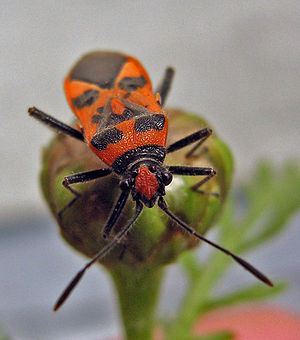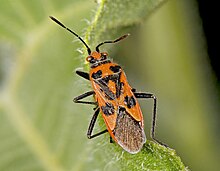Cinnamon bug
| Cinnamon bug | ||||||||||||
|---|---|---|---|---|---|---|---|---|---|---|---|---|

Cinnamon bug ( Corizus hyoscyami ) |
||||||||||||
| Systematics | ||||||||||||
|
||||||||||||
| Scientific name | ||||||||||||
| Corizus hyoscyami | ||||||||||||
| ( Linnaeus , 1758) |
The cinnamon bug ( Corizus hyoscyami ) is a conspicuously red-black colored bug (Heteroptera) that belongs to the family of glass wing bugs (Rhopalidae). These bugs have a slight cinnamon odor - hence the German name.
Distribution and habitats
The cinnamon bug is common in large parts of Europe and Asia. It prefers sunny and dry ruderal areas rich in flowers and is found there relatively often. Sometimes the animals can be seen in gardens.
Features and way of life
The cinnamon bug reaches body lengths between 10 and 12 millimeters. Although it is one of the glass wing bugs, in contrast to most members of this family, its hemi -coverts ( hemielytres ) are neither translucent between the corium veins, nor are their membranes (the membranous parts of the forewings) hyaline or crystal clear. She wears a striking red warning costume with characteristically arranged black spots. The forehead ( frons ) is red, the compound eyes black. The pronotum shows two black spots at the base and a black border in front. The scutellum is only red at the tip. The forewings have two distinctive black spots in the middle. The membrane is blackish and has more than 20 longitudinal veins. The antennae are as black as the legs. The animals are densely hairy on the upper side of the body.
Cinnamon bugs feed on plant juices. They mainly suckle on fruits and seeds of sunflower (Asteraceae) and mullein ( Verbascum ). The animals overwinter in the adult stage in the litter and under plants. From May onwards, mating and oviposition mainly take place on aster family. The adult animals of the new generation can be observed from September.
The species can easily be confused with the knight bug ( Lygaeus equestris ) or the common fire bug ( Pyrrhocoris apterus ). However, both species belong to different kin groups and are not hairy. Furthermore, its pattern is clearly different from that of the cinnamon bug.
literature
- E. Wagner: Heteroptera Hemiptera. - In: Brohmer, P., P. Ehrmann & G. Ulmer (eds.): Die Tierwelt Mitteleuropas. IV, 3 (Xa). - Leipzig 1959, 173 pp.
- E. Security guard : Bugs - get to know, watch. Neumann-Neudamm 1989, ISBN 3-7888-0554-4
Web links
- Axel Steiner: Nature in NRW
- Corizus hyoscyami at Fauna Europaea
